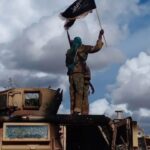KISMAYO, Somalia – As the African Union Transition in Somalia force, known as ATMIS, reduces troop numbers, a Somali official is warning the plan is ill-conceived and raises the risk of al-Shabab militants retaking areas they lost.
The deputy president of Jubaland, a region where Kenyan and Ethiopian troops operate, told VOA Somali that it will be “difficult” for Somali forces to secure areas being vacated by the AU troops.
“There is going to be a danger from there,” Mohamud Sayid Aden said Tuesday. “The enemy is going to get [an] advantage. The civilians who relied on the Somali and ATMIS forces will face revenge [from al-Shabab militants].”
The AU peacekeeping mission in Somalia has completed handing over six military bases to Somali forces last week. A seventh base was closed down.
The AU wants to gradually reduce the number of troops until December of 2024, when the mission concludes.
The drawdown of the 2,000 soldiers, 400 from each of the five troop-contributing countries – Burundi, Ethiopia, Djibouti, Kenya and Uganda – will bring the size of the force down to 16,586.
The AU has agreed with the Somali government to pull out another 3,000 troops by the end of September.
“It’s a plan not well-thought out, it’s hasty,” Aden said.
Aden called for the drawdown to be “paused and reviewed.”
But other Somali officials disagreed. Yasin Abdullahi Mohamud, known as Farey, is a member of the parliament, and the former director of the National Intelligence and Security Agency. He is currently among the officials mobilizing local forces against al-Shabab.
He said Somalis are grateful to the AU forces but the decision for the drawdown is not a hasty move.
“It’s the right time for the forces to leave,” he said. “It’s essential the national armed forces takeover responsibility of the security.”
Mohamud said ATMIS forces were not largely involved in the military operations against al-Shabab within the last year, and he asserted the time has come for Somali forces to step up.
The AU troop drawdown is coming at a time when the federal government is preparing to resume military operations against al-Shabab that were interrupted by rains and deadly militant attacks.
The Somali government is also preparing a second phase of operations dubbed the “Black Lion.” Troops from Somalia’s neighbors Ethiopia, Djibouti and Kenya are slated to participate.
An AU official who requested anonymity told VOA Somali that he doesn’t expect all 2,000 of the troops being withdrawn to be unavailable to Somalia. He said troops from Ethiopia and Uganda could continue to support the Somali National Army in fighting against al-Shabab on a bilateral basis – that is, not affiliated with ATMIS.
The drawdown also coincided with increased al-Shabab attacks in Somalia and in the neighboring Kenya. In late May, al-Shabab carried out deadly attacks on AU and Somali forces in the towns of Bulo Marer and Masagaway, killing dozens of soldiers.
Additionally, al-Shabab also increased attacks in Kenya in recent weeks. As many as 15 attacks have been recorded in the coastal Lamu and Northeastern regions, some of which killed soldiers and civilians.
Somali officials contend the group’s strategy is to protect the corridor between Somalia and Kenya, which its militias use to carry out attacks on either side of the border.
Some officials, including Aden, say al-Shabab attacks in Kenya are an indication the group wants to continue fighting inside Kenya if defeated in Somalia.
“Yes, they could continue the war in Kenya if they are destroyed in Somalia,” he said.
“They will move to the [Boni] forest, the wetland along the coast on either side of the border. They want to keep hiding there and try to make a comeback, and attack areas seized from them, and to carry out ambushes and violence.”
Al-Shabab, an Islamist radical group, has been fighting for control of Somalia since 2007.
Kenya lawmaker Bashir Abdullahi who represents Mandera, a county that has seen increased al-Shabab activities, agrees the recent attacks can be attributed to the pressure the group faces inside Somalia from local fighters and the Somali government.
“They are sort of looking for an escape route or where to hide, and the place which is bordering happens to be Northeastern Kenya,” he said.
Abdullahi expects even more attacks if Kenya troops participate in the next phase of military operations as expected.
“Certainly al-Shabab will still retaliate,” he said. “They did that even before by virtue of us, Kenya, being part of AMISOM, so we believe this could also be the same.”
Abdullahi rejects the assessment al-Shabab is so entrenched in Kenya that it can continue fighting there if they are defeated in Somalia.
“Of course, there is that possibility of saying if they are removed or the heat is so much on them inside Somalia, them coming toward Kenya, that is a possibility,” he said.
“But them being entrenched just like they do in Somalia, I don’t think that can happen…there is no way they can operate further.”







